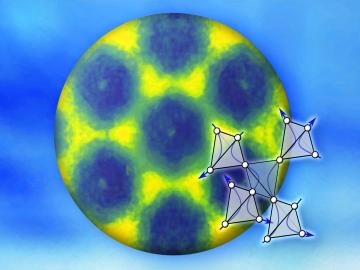
Filter News
Area of Research
- (-) Fusion Energy (2)
- (-) Materials (86)
- (-) Neutron Science (21)
- Advanced Manufacturing (8)
- Biology and Environment (15)
- Computer Science (1)
- Electricity and Smart Grid (1)
- Energy Science (44)
- Functional Materials for Energy (1)
- Fusion and Fission (6)
- Isotopes (2)
- Materials Characterization (1)
- Materials for Computing (15)
- Materials Under Extremes (1)
- National Security (14)
- Nuclear Science and Technology (4)
- Quantum information Science (8)
- Supercomputing (34)
- Transportation Systems (1)
News Type
News Topics
- (-) Composites (7)
- (-) Cybersecurity (4)
- (-) Materials Science (56)
- (-) Microscopy (19)
- (-) Physics (17)
- (-) Polymers (13)
- (-) Quantum Science (5)
- 3-D Printing/Advanced Manufacturing (18)
- Advanced Reactors (10)
- Artificial Intelligence (10)
- Big Data (2)
- Bioenergy (11)
- Biology (7)
- Biomedical (13)
- Buildings (3)
- Chemical Sciences (20)
- Clean Water (4)
- Computer Science (20)
- Coronavirus (6)
- Critical Materials (6)
- Energy Storage (25)
- Environment (14)
- Exascale Computing (1)
- Fossil Energy (1)
- Frontier (3)
- Fusion (15)
- Grid (3)
- High-Performance Computing (4)
- Hydropower (1)
- Irradiation (1)
- Isotopes (10)
- ITER (1)
- Machine Learning (6)
- Materials (58)
- Mathematics (1)
- Molten Salt (2)
- Nanotechnology (28)
- National Security (2)
- Neutron Science (89)
- Nuclear Energy (21)
- Partnerships (4)
- Quantum Computing (4)
- Security (2)
- Simulation (1)
- Space Exploration (5)
- Summit (3)
- Transportation (14)
Media Contacts

A team of researchers at Oak Ridge National Laboratory have demonstrated that designed synthetic polymers can serve as a high-performance binding material for next-generation lithium-ion batteries.

Scientists have discovered a way to alter heat transport in thermoelectric materials, a finding that may ultimately improve energy efficiency as the materials

OAK RIDGE, Tenn., March 22, 2019 – Karren Leslie More, a researcher at the Department of Energy’s Oak Ridge National Laboratory, has been elected fellow of the Microscopy Society of America (MSA) professional organization.

Scientists have tested a novel heat-shielding graphite foam, originally created at Oak Ridge National Laboratory, at Germany’s Wendelstein 7-X stellarator with promising results for use in plasma-facing components of fusion reactors.

Oak Ridge National Laboratory scientists studying fuel cells as a potential alternative to internal combustion engines used sophisticated electron microscopy to investigate the benefits of replacing high-cost platinum with a lower cost, carbon-nitrogen-manganese-based catalyst.

Researchers used neutron scattering at Oak Ridge National Laboratory’s Spallation Neutron Source to investigate bizarre magnetic behavior, believed to be a possible quantum spin liquid rarely found in a three-dimensional material. QSLs are exotic states of matter where magnetism continues to fluctuate at low temperatures instead of “freezing” into aligned north and south poles as with traditional magnets.

Carbon fiber composites—lightweight and strong—are great structural materials for automobiles, aircraft and other transportation vehicles. They consist of a polymer matrix, such as epoxy, into which reinforcing carbon fibers have been embedded. Because of differences in the mecha...
Physicists turned to the “doubly magic” tin isotope Sn-132, colliding it with a target at Oak Ridge National Laboratory to assess its properties as it lost a neutron to become Sn-131.

Three researchers from the Department of Energy’s Oak Ridge National Laboratory have been elected fellows of the American Physical Society (APS). Fellows of the APS are recognized for their exceptional contributions to the physics enterprise in outstanding resear...

An Oak Ridge National Laboratory-led team used a scanning transmission electron microscope to selectively position single atoms below a crystal’s surface for the first time.


